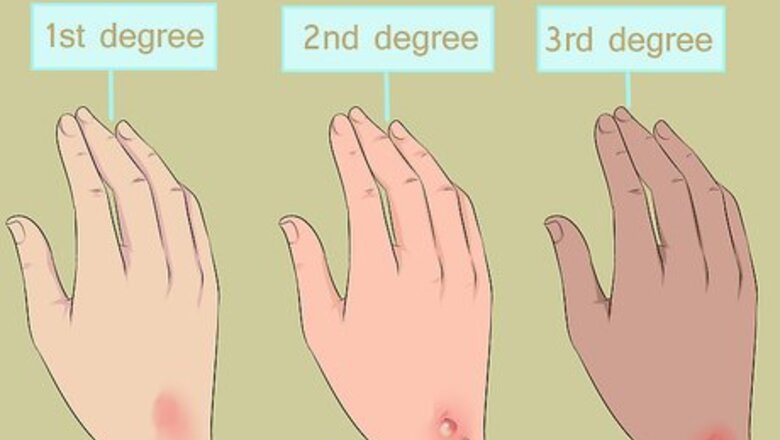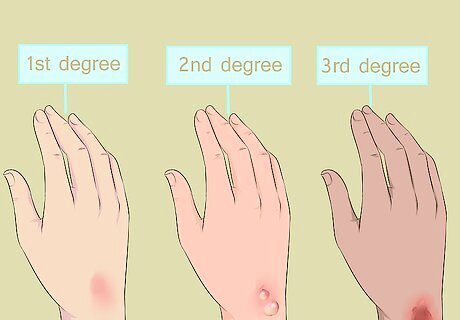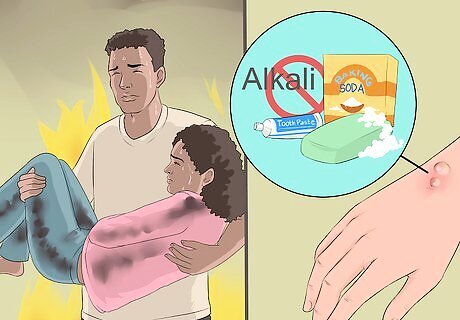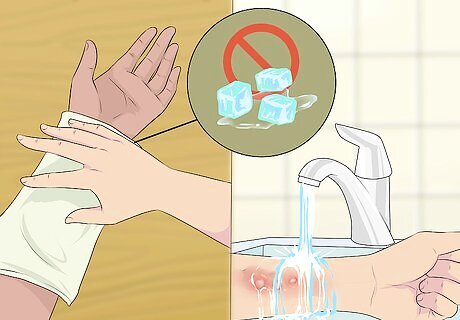
views
- Assess the damage and figure out whether it’s a first, second, or third-degree burn; remove the burning agent and any hot or smoldering material.
- Cool the burn and cover it with a clean bandage; stay in a position that prevents shock, manage the pain with medication, and follow up with a doctor.
- For third-degree burns, call emergency services; protect the burn with a non-stick bandage and elevate the legs slightly to avoid shock.
- Get rid of contaminated gear and wash a chemical burn, unplug the source of the shock for electrical burns, and wash plastic burns before bandaging them.
Treating a First or Second-Degree Burn

Assess burn damage. Check to see if the burn is a first, second, or third-degree burn. If the burn was caused by chemicals, an electrical shock, or molten tar or plastic, understand that burn will require different first aid than a burn caused by a thermal source such as fire. First-degree burns only impact the top layer of skin. These burns do no blister. Though they may be painful, they often heal in under a week, and do not scar. Second-degree burns extend beneath the top layer of the skin into the dermis. These burns usually blister, and cause pink, moist injuries that may heal with some scarring. Third-degree burns extend all the way through the dermis. They may or may not have blisters, and often appear white, brown, bright red, or black. They may or may not peel. When evaluating people with severe body burns, you have to assess the burn damage. This is accomplished by the rule of 9’s. This helps guide clinical decisions such as fluid resuscitation and pain control. Clinicians use this in severe traumatic third degree burns over a large surface area of the body.

Remove the burning agent. No matter what type of burn a person is experiencing, the first step in treating it is to smother or remove the burning agent. This means putting out the fire, or otherwise removing any hot liquid, steam, chemicals, or electrical components from the person’s skin. If a person has contact with fire, get them out of the way of the fire source. If necessary, help them “stop, drop, and roll” to extinguish the flames. Chemicals should be removed with care. Gloves and protection for the eyes, mouth, and nose should be worn while handling chemicals that may cause burning. Never put an alkali on an acid burn, and never put an acid on an alkali burn. Use copious amounts of water to dilute the alkali or acid/chemical burn. Electrical components should be handled with care, as well. If possible, allow a professional to intervene in the situation. In most situations, it is unlikely that you will have to pull someone away from an active electrical component.

Remove any hot, charred, or smoldering material. Remove any clothes and other material from the burned area. If fabric is sticking, cut around it to expose as much of the burn as possible. Do not try to remove sticking fabric or embedded objects from the skin. Leave this to a trained medical professional so as to avoid further injury. Remove all restrictive clothing such as jewelry and belts, and loosen ties, shirt cuffs, and collars. Burns can cause rapid swelling, and restriction may cause further injury.

Cool the skin. Cool the burned skin using cool water or a cool compress. Avoid applying ice or near-freezing water to the burned area, as this can constrict blood flow to the burn and worsen the injury. If possible, cool the burn by placing it under clean running water for up to 20 minutes at a time. If running water is not practical, the burn may be placed in a bowl or tub of cool water. A cool compress may be used to treat first degree burns if a constant running water source is not available. You may find one in a first-aid kit, or make one using cool water and a clean towel. Hold it over the burn for no more than 20 minutes.

Cover the burn. Apply a protective covering to the burn such as a sterile, non-adhesive bandage or a clean cloth. Do not use an adhesive bandage or previously-used gauze. Avoid applying ointments or other treatments to the burnt area, as this may cause infection. Wrap dry gauze or a burn dressing loosely around the burnt area. Do not apply too much pressure or constrict the burn with the dressing.

Care for blisters. Do not pop any blisters that may have resulted as a part of the burn. Wrap the blisters loosely in the same way as the rest of the burn, and keep them from any stress that may cause them to rupture. If a blister does pop, keep it wrapped in a sterile dressing. Do not apply an ointments or other treatments, as these may cause infections.

Prevent shock. Keep the burn victim in a position that helps prevent shock by laying the person down and elevating their legs and the burn area above the level of their heart, if possible. Use props or furniture to help the individual hold the pose, and cover them with a coat or blanket. Do not move the individual if they have injuries around the head and neck or spinal area unless you have been trained to do so by a reputable first-aid program. Moving them incorrectly with such injuries could result in permanent damage to the body or brain. Shock is one of the more serious concerns of a large 2nd or 3rd degree burn and should be dealt with in a burn unit or ICU, or the burn victim may die.

Manage the pain. An over-the-counter pain medication such as acetaminophen or ibuprofen can help manage the pain for a first-degree burn. Take as recommended on the manufacturer’s packaging. If an over-the-counter medication does not work to alleviate the pain, contact your doctor for further recommendations. You can also apply pure aloe gel to reduce the inflammation around your burn.

Follow up with your doctor. All burns should be seen by a doctor, even first-degree burns. Follow up with your doctor when you can get an appointment. Request expedited service if you or the burnt individual believe a tetanus booster is necessary, or if you notice symptoms like: Oozing Swelling Fever Worsening redness Increased pain
Treating a Third Degree Burn

Call emergency services. First-aid can be administered to help third-degree burns while waiting for medical attention, but such severe burns always require treatment by a medical professional. Call emergency services, such as 9-1-1 in the US, and let them know a severe burn needs treatment. Be prepared to tell the dispatcher your location, what happened to cause the burn, and about the severity of the burn. Request an ambulance be sent immediately. It is not advisable for untrained individuals to transport someone suffering from a severe burn unless absolutely necessary.

Protect the burn. Loosely cover the burn with a sterile, non-stick bandage such as gauze or a burn dressing. If the individual has sustained a large burn, a clean, lint-free sheet or other non-linting fabric may be used. Use a sterile dressing to separate burned fingers and toes in addition to any other dressings being applied to the burn. Do not soak or cool the burn prior to dressing it, and do not use any ointments or topical treatments on the burn. These may lead to infection. Do not remove any clothing or other material stuck to the burn area.

Avoid shock. Lay the person down flat and elevate the legs slightly and the burned area to above the level of the heart, if possible. Use props to help them keep this position without exerting great effort. Do not move the person if they have sustained additional injury to their head, neck, or spine. Cover the person with a blanket or jacket once they are in position. Monitor the person’s heart rate either on their wrist or on their neck, if possible, and watch for a rising and falling chest to indicate breathing. Do this until emergency help arrives.

Get to a hospital. Emergency services should bring the burn victim to a local hospital. There, doctors can treat the burn and additional injuries, as well as provide fluids and oxygen as necessary. Once the individual has been treated, ask the doctor about what is expected for aftercare, as well as follow-up visits. Try asking, 'What kind of aftercare will be required to make sure the burn heals properly? When will the burn need to be seen by a doctor again?" Stick to the doctor’s prescribed aftercare routine and medicines as precisely as possible. Keep all follow-up appointments during recovery.
Caring for Non-Thermal Burns

Care for a chemical burn. Chemical burns are generally best cared for by removing the victim from the contaminated area and removing contaminated clothing. From there, dilute the chemical on the skin by washing it consistently with fresh, running water. Wash the affected area for at least 20 minutes. Chemical burns can be caused by a number of products, including household cleaners such as drain cleaners which contain sulphuric acid, refrigerant which contains hydrofluoric acid, and bleach. If available, use a chemical shower or eye rinse station to rinse the burn. Use copious amounts of water to dilute the chemical burn. Even if the burn is small or isolated, contact a doctor immediately to assess whether the victim should come in for care and to discuss treatment.

Manage an electrical burn. Unplug the source of the electrical shock if possible, or stand on a rubber mat in a dry area and use a dry wooden object to push the person away from the electrical source. Once contact with the electrical source has been broken, check for a heartbeat and see if the individual responds to talk or touch. After the individual has been safely removed from the electrical source, call emergency services immediately. Major electrical burns may come with other complications that need immediate medical treatment. Even minor electrical burns should be examined by a doctor as soon as possible. Never directly touch a live electrical source or a person caught in such a source yourself.

Deal with a plastic burn. If a burn results from molten plastic or tar, immediately cool the plastic or tar by running it under cool water. Do not peel off the plastic or tar. Instead, use mineral oil to see if you can remove it. Then, treat the burned skin by washing it with cool water and loosely bandaging it in a clean dressing. Contact your doctor if you cannot gently remove the plastic or tar from your skin, or if you experience excess pain from the burn. Do not dress the exposed burn with any ointments, as these may cause infection.




















Comments
0 comment